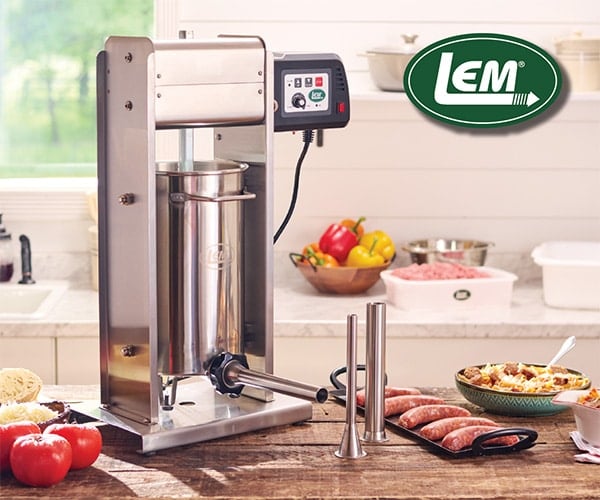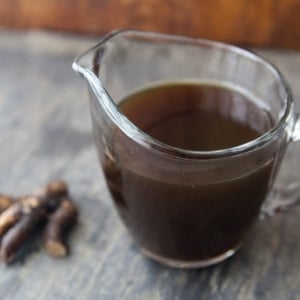As an Amazon Associate I earn from qualifying purchases.

If you like root beer, you like sassafras. And making your own root beer syrup is super easy.
The aromatic bark, leaves and roots of this little tree are believed to be the first plant exported from North America to Europe, back in the late 1500s. All parts of this little tree make for delicious — and different — teas, sweets and other confections, and sassafras commanded exorbitant prices in Europe… until everyone started drinking sassafras tea to cure their syphilis. Soon no one wanted to be seen sipping their syphilis cure in public, and the sassafras trade withered.
More recently, sassafras has been getting a bad rap by the folks at the USDA, who say that the active component of sassafras, safrole, is a “known carcinogen.” Why? They gave tons of pure safrole to rats and the rats got cancer. Later researchers noted that, like the whole saccharine scare in the late 1970s, safrole seems to cause cancer in rats — but not people.
Still, many people still think that sipping sassafras tea or eating sassafras ice cream will doom you to a date with your oncologist. Just know that there are many times more “known carcinogens” in a bottle of beer than there are in any homemade sassafras product you might make. By one calculation, you’d need to drink 24 gallons of sassafras root beer a day for an extended time to get the amount of safrole fed to those rats.
And if you drank that much soda, you’d have lots of other problems to deal with…
I collect sassafras on Cape Ann, where my family lives. It’s easy to spot its telltale mitten leaves. Sassafras is unmistakable. It is a spindly, shrubby tree that lives beneath larger trees. Its upper bark is green, and the leaves come in three varieties, often on the same branch: a mitten, a three-lobed leaf, and a simple spear-shaped leaf.
The way you collect sassafras is to pull seedlings right out of the ground. I know, it sounds destructive, but it isn’t. Sassafras grows in clumps, and the parent tree sends out suckers under the ground, which then become seedlings; it’s a lot like mulberry.
You find a clump — look for at least 8 to 10 treelings scattered about — go to one about 2 or 3 feet tall, grasp the very base of the tree and yank it straight up. You should come away with the seedling and about 10 inches’ worth of the root.
You did not get all of the root, you know, and this is a good thing. It will regrow later. So what seems a little destructive is actually good for the sassafras cluster — it lets the surrounding seedlings grow with less competition.
All parts of this tree are useful. Notice I did not say “edible,” because the leaves are the only part you actually eat. You know them as filé powder, and without sassafras leaves gumbo just isn’t gumbo.

Roots on the left, twigs on the right. What’s the difference? They make very different teas. The twigs have a lemony-floral flavor and aroma that one author has compared to Froot Loop cereal — not exactly a selling point in my book, but they are lovely. The roots, however, are the “root” in root beer.
I am not a tea drinker. Coffee is my breakfast drink of choice. So I was not about to switch for sassafras. But I do like using flavored syrups from wild ingredients; I recently made a delicious fir tip syrup from the young tips of a Douglas fir tree. I then use these syrups to glaze meats, make homemade sodas, sorbets or ice creams. Sassafras is a prime candidate for this treatment.
To make a twig syrup, you peel back the green bark a bit to expose it — the bark is what has most of the flavor — then simmer the twigs in hot water. The brew quickly turns a pretty amber, a little like cola. Let it steep overnight and then strain it through cheesecloth and mix it 1:1 with sugar to make a simple syrup. It is outstanding. I mean, really outstanding. Think root beer with a lot of lemon in it.
To make root beer syrup, the first thing you need to do it chop the sassafras roots.

Sassafras is the prime flavor in root beer, but not the only one. Root beer is a concoction of many things. My recipe is heavy on the sassafras roots, plus some burdock root, molasses for color, one clove, a star anise, some coriander seed and one drop of wintergreen extract.
It really does taste like store-bought root beer! Maybe not the root beer you get in a can now, but then that no longer has any real sassafras in it. It is warm, and zingy, and, well, deliciously rooty.
If you live near sassafras trees — and you do if you live east of the Great Plains, south of Quebec and north of Orlando — by all means make this root beer syrup. If you don’t live there, or don’t feel like foraging, you can buy sassafras root bark online. You’ll never go back to store-bought root beer again.

When you make your root beer, start with a tablespoon of this syrup to a pint of seltzer water. You can adjust the strength of your drink from there.
Homemade Root Beer Syrup
Ingredients
- 6 cups water
- 3 ounces sassafras roots
- 1 ounce burdock or dandelion root
- 1/4 cup molasses
- 1 clove
- 1 star anise
- 1 teaspoon coriander seeds
- 2 drops wintergreen or peppermint extract
- 6 cups sugar
Instructions
- Chop the sassafras and burdock roots into small pieces, about 1/2 inch or smaller.
- Put the roots in a medium-sized heavy pot with the clove, star anise and coriander seeds and cover with the water. Cover the pot and bring it to a boil. Simmer this for 15 minutes.
- Add the molasses and simmer another 5 minutes.
- Turn off the heat and add the wintergreen or peppermint extract. Put the cover back on the tea.
- When the mixture cools, strain it though cheesecloth to remove any debris.
- Return it to the pot with an equal amount of sugar. Stir to combine. Bring it to a simmer and cook it for 5 minutes, uncovered. Pour into quart mason jars and seal. Keeps a year in the fridge.
Notes
Nutrition information is automatically calculated, so should only be used as an approximation.







Hello. Have not tried the recipe yet. Had a few questions, like:
Have you tried roasting the sassafras root? Wondering what yummy complexity that might bring in.
Also, would you condone using chicory and/or mixture of dandelion and chicory in place of the burdock? I just have a jar of those grounds always in stock so trying to be a little lazier…
And, lastly, I’ve heard most foraging articles mention harvesting the bark layer off the root. In your recipe, it was shortened to just “root” so I just wanted to clarify that I should only use the bark layer that’s moist and easily peels off, right? Can you use the woody part also?
Liz: I use the whole root. Yes on chicory. And no, I have never roasted the roots.
Thank you so much for this delicious recipe and wonderful how to guide. The root beer was super straightforward to make and a huge hit in my house.
THANKS! I also didn’t know these types of tree were in root beer. Weird huh?
How to make sugar free? Or maybe a combo of stevia and or monk fruit w a bit of maple syrup?
I want to make 48 oz of syrup. How much should I increase this recipe?
The recipe looks really good and I want to try it but need to reduce sugars in my diet for health reasons. Do you have suggestions to reduce the calories and sugar?
Thanks.
I’d like to try your recipe but don’t know what type of clove you’re referring to. 1 clove of what? Please advise. Thanks
Cindy: A clove. You know, cloves. The spice.
How much of this syrup would you use per batch of root beer, and how big is the batch?
Joseph: Not sure what you mean. I use about a tablespoon per pint of soda water.
How long would you expect this syrup to last in the fridge?
Cara: A year or so.
I just made this today and and my son help me gather the ingredients from our property and we are both extremely satisfied with how it turned out
My boyfriend is overseeing a construction project here in Fredericksburg, VA and they are clearing the land. Amongst many, many great foraging finds, was a tree they tore up and as soon as he “smelled” it, he was like “omg, that’s sassafras!” He and his grandmother used to forage for it in Missouri, and we talk often of foraging with our Grandparents (Missouri and North Carolina, respectfully), but here we are in Virginia, and there it was! I visit your site often and so when I googled “sassafras root” and your site came up, I’m like “this is my guy” I can’t wait to try this recipe! P. S. he brought a root into the house and said “here smell this” which of course I thought was going to be a prank and as soon as I did i was like “omg, sassafras! what the heck!?” score…. now my whole kitchen smells like root beer and I haven’t even brewed it yet ? Thanks for the recipe!
i’ve had sassafras in my backyard in central Virginia for the past 17+ years, and have done nothing with it. just now getting around to researching the possibilities. thank you for your contribution~!
Hey there KMS: saw your post when I was looking for things to do with sassafras root. I also live in Virginia (Fredericksburg) and we just foraged some sassafras root. Wondering, did you find any other interesting things to make/& do with the root? Thanks!